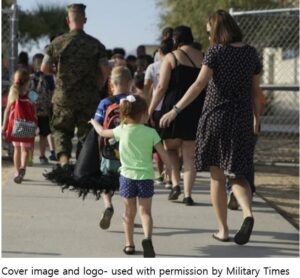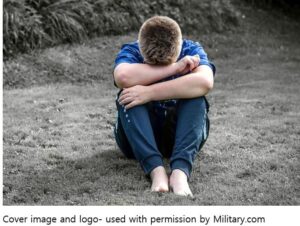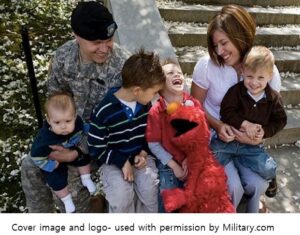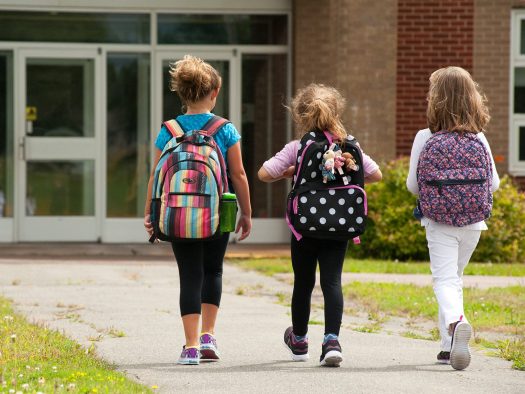by Jennifer Rea, PhD
 The Department of Defense (DoD) Demographics Report (2017) states that 1.7 million children and adolescents have one (or both) parent serving in the U.S. military. According to the report, 1 million of these children have active duty parents and 683,000 have parents serving in the Reserve or Guard. Out of the 1.7 million children, 55% are in the K–12 education range of 6–18 years (DoD, 2017).
The Department of Defense (DoD) Demographics Report (2017) states that 1.7 million children and adolescents have one (or both) parent serving in the U.S. military. According to the report, 1 million of these children have active duty parents and 683,000 have parents serving in the Reserve or Guard. Out of the 1.7 million children, 55% are in the K–12 education range of 6–18 years (DoD, 2017).
The vast majority – nearly 80% – of military students attend public schools throughout the United States. Of the 13,584 total U.S. public school districts, only 214 districts are considered “military-connected school districts”. Very few school districts serve at least 400 military-connected students or more than 10% of their total student enrollment are military children (De Pedro et al., 2018). Military children might be the only one or one of few in their school district. Thus, it can be difficult for school-based providers to provide support if they do not know who the military children are (Fletcher & Albright, 2016).
Children in military families are resilient but face unique challenges that are not comparable to the general, civilian student population. As military families transition from one duty station to another, children often enter and leave schools that vary dramatically, with different cultures or graduation requirements.
The average child in a military family will:
– Move 6 to 9 times during a school career (Ruff & Keim, 2014), an average of 3 times more frequently than non-military families; and
– Relocate every 1-4 years (Bradshaw, Sudhinaraset, Mmari, & Blum, 2010)
Through the changes and transitions like moving, shifting schools, leaving friends, military children may experience a fear of loss (e.g., worrying about a loved one’s safety) or actual loss, such as coping an injury or death of a parent (Fletcher & Albright, 2016)
Over time, military children may be affected to varying degrees (e.g., mental health, well-being) in an immediate or more long-term sense by their surroundings. Increased stress is undoubtedly experienced by military students and their families as a result of frequent transitions combined with deployment. For some children, “the more frequent the transitions, the more turbulent the transitions become” (Center for Public Research & Leadership at Columbia University (CPRL), 2017).
Oftentimes, the buildup of these stressors impacts military students’ academic experience and achievement (Astor, De Pedro, Gilreath, Esqueda, & Benbenishty, 2013). At times, the buildup of these stressors then leads into additional challenges, such as behavioral problems, social-emotional struggles, and reduced social connections (Fletcher & Albright, 2016).
Mental health issues are more common among military-connected  adolescents (12-18 years) who have experienced at least one parent deploying (De Pedro et al., 2018). In the past year, around 30% of military adolescents reported feelings of depression, and 1 in 4 has considered suicide (Puskar et al., 2018). These outcomes likely stem from prolonged parent separation due to deployment, household financial stress, increased household roles and responsibilities, lack of access to support, left-behind parent anxiety, and exposure to returning parent’s veteran war trauma (De Pedro et al., 2018).
adolescents (12-18 years) who have experienced at least one parent deploying (De Pedro et al., 2018). In the past year, around 30% of military adolescents reported feelings of depression, and 1 in 4 has considered suicide (Puskar et al., 2018). These outcomes likely stem from prolonged parent separation due to deployment, household financial stress, increased household roles and responsibilities, lack of access to support, left-behind parent anxiety, and exposure to returning parent’s veteran war trauma (De Pedro et al., 2018).
Unfortunately, schools may not be “viewed as a supportive environment where children feel safe enough to address stressors and transitions as they occur” (Astor et al., 2013). This is likely due to the communities where schools are geographically located varying in the degree to which a military presence is “visible” or “invisible” (De Pedro et al., 2018). Thus, it’s likely that military students’ educational needs and strengths may go unrecognized as they move among schools (CPRL, 2017).
Despite adversity, several coping strategies have been identified to help military youth adjust to new school environments, including:
• Self-regulation skills, such as being able to cope and thrive while a parent is deployed;
For example, military children coped with deployment stress when adults in their community provided emotional support and encouragement (De Pedro et al., 2014). 
• Community and societal protective factors, such as:
Strong connections with a local military installation or having a solid group of friends and family; and
• School-based approaches that promote belonging and connectedness, such as; School activities, clubs, and cultural displays (i.e., bulletin boards) to help create a sanctuary for students experiencing social and emotional strain (Chandra et al., 2010).
School-and Transition-Related Resources for Military Children and Their Families
Military One Source has developed a comprehensive list of benefits and programs to effectively meet school-and transition-related needs of military children and their families. Here are some resources they mention on their website.
Education-Specific Resources for Military Families
Here are a few programs that were designed to ensure quality educational opportunities for all military and veteran-connected children affected by mobility, transition and family separation:
• The Interstate Compact on Educational Opportunity for Military Children is an agreement among participating states to help alleviate some of the school transition problems that happen with frequent moves.
• The Non-Department of Defense Schools Program provides support and funding if you’re stationed overseas and want to home-school your child. Visit the website to review eligibility.
• The Military Child Education Coalition provides programs that help military and veteran-connected children with support for mobility, transitions and family separation. The site also has resources for parents and professionals.
• Special needs consultants through Military OneSource can point you to benefits that are available for families with special needs.
• The Department of Defense Education Authority also gives grants to school districts with school-age military children.
Military Children and Youth Program Resources
Each service branch has its own child and youth program, offering affordable instructional and educational programs as well as flexible child care. The programs provide age-appropriate activities in a structured setting either on or off the military installation. Here are a few to check out:
• Sesame Street offers resources for military children and their families, as well as tools for professionals that help children build the skills they need to be resilient, such as self-confidence, problem-solving skills, and emotional tools.
• Military Kids Connect offers engaging tools and games to help children, pre-teens and teens prepare for the challenges around family transitions. The site also has resources for parents and teachers.
• Boys & Girls Clubs of America offers children between the ages of 6 and 18 a solid support network that provides a sense of belonging, ongoing relationships with caring adults and a safe and healthy environment to develop lifelong skills.
• 4-H Military Partnerships creates opportunities and provides support to military connected youth through 4-H clubs that provide consistency in belonging and an opportunity to develop life skills through a positive youth development framework. Find a local 4-H club here
• Operation Purple® Camp from the National Military Family Association brings together military kids from all services and offers a Family Retreat that provides military families with a chance to reconnect and bond.
• Our Military Kids offers grants to National Guard and Reserve families during deployments. The grants are to help with children’s activities when families have trouble accessing support services from military installations.
Want to learn more? Find additional resources for helping military children and youth build the skills to be resilient and overcome other transition-related challenges, be sure to head on over to our Family Transitions page ! Also, take a look at our upcoming webinar, “Promoting Successful Home-to-School Transitions for Military Families with Young Children”. This webinar will focus on promoting positive transitions from home-to-school and from school-to-school (e.g., during a move) for young children and their families. This webinar will take place on November 6th at 11:00 am EST, so be sure to RSVP today!
View archived webinar and materials for Promoting Successful Home-to-School Transitions for Military Families with Young Children, at: https://oneop.org/event/52250
Infographic: Highly Mobile, but Very Resilient [Military Youth]
This article was written by Jennifer Rea, PhD and military spouse to an Active Duty Marine. Jenny consults with the OneOp Family Transitions to support professional development for military family service providers. You may find more blogs, podcasts and webinars from Family Transitions here. We invite you to engage with Family Transitions on Twitter @MFLNFT and with OneOp on Facebook @MilitaryFamilies.
References
1. Astor, R. A., De Pedro, K. T., Gilreath, T. D., Esqueda, M. C., & Benbenishty, R. (2013). The promotional role of school and community contexts for military students. Clinical Child and Family Psychology Review, 16(3), 233-244.
2. Bradshaw, C. P., Sudhinaraset, M., Mmari, K., & Blum, R. W. (2010). School transitions among military adolescents: A qualitative study of stress and coping. School Psychology Review, 39(1).
3. Center for Public Research & Leadership at Columbia University (CPRL). (2017). The Challenges of Supporting Highly Mobile, Military-Connected Children in School Transitions. Retrieved from https://cprl.law.columbia.edu/sites/default/files/content/docs/military_student_transitions_study_2017_mcec.pdf
4. Chandra, A., Lara-Cinisomo, S., Jaycox, L. H., Tanielian, T., Burns, R. M., Ruder, T., & Han, B. (2010). Children on the homefront: The experience of children from military families. Pediatrics, 125(1), 16-25.
5. Department of Defense (DoD). (2017). 2017 Demographics Report: Profile of the Military Community. Retrieved from https://download.militaryonesource.mil/12038/MOS/Reports/2017-demographics-report.pdf
6. De Pedro, K. T., Astor, R. A., Gilreath, T. D., Benbenishty, R., & Berkowitz, R. (2018). School climate, deployment, and mental health among students in military-connected schools. Youth & Society, 50(1), 93-115.
7. De Pedro, K. T., Atuel, H., Malchi, K., Esqueda, M. C., Benbenishty, R., & Astor, R. A. (2014). Responding to the needs of military students and military-connected schools: Perceptions and actions of school administrators. Children & Schools, 36(1), e18-e25.
8. Fletcher, K. L., & Albright, D. L. (2016). Barriers to supporting military-connected children within civilian schools: A mixed methods study. Journal of Military and Government Counseling, 4(2), 66-89.
9. Puskar, K., Sun, R., Gleeson, A., Lampl, T., Nichols, D., & Khan, N. (2018). MilTeenChat app to promote coping resilience in military youth. Journal of Military and Veterans Health, 26(1), 42-46.
10. Ruff, S. B., & Keim, M. A. (2014). Revolving doors: The impact of multiple school transitions on military children. Professional Counselor, 4(2), 103-113.















